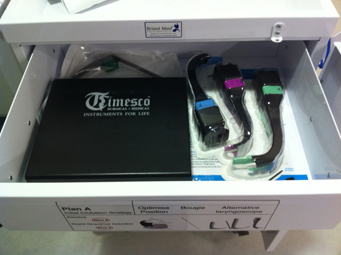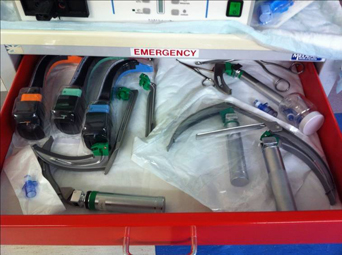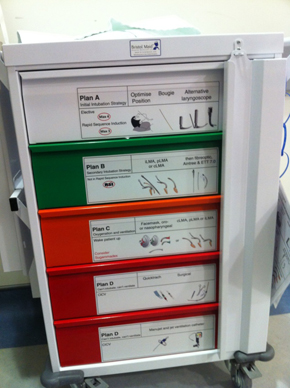The following is intended to be an aid to putting together a logically and comprehensively stocked DAT that is fit for purpose for the individual Trust within which it will be used.
The Association of Anaesthetists of Great Britain and Ireland (AAGBI) in their Safety Guideline – Checking Anaesthetic Equipment 2012 states that “equipment for the management of the anticipated or unexpected difficult airway must be available and checked regularly in accordance with departmental policies.”1
A number of excerpts from the NAP4 Project have been highlighted in the appendix below which attest to the importance placed on a suitably stocked DAT which is available in ALL necessary areas that, at the very least conforms, to a local if not national standard.2
Ideally one trolley will be required per area that anaesthesia is delivered which in most Trusts is likely to be several different places. It is up to the various interested and invested parties as to how many might be required, but the emphasis should be on conformity such that a DAT in main theatres is the same as the one in daycase and the same as the one in the ED and CT/MRI for example.
This means that in an emergency the anaesthetist will always know exactly what to find in each drawer and more importantly will be capable of using that piece of equipment.
It would be impossible to provide an absolute list in terms of exact makes of equipment as this might offer an unfair and uncompetitive advantage to one manufacturer over another. The principles are relatively simple in that each anaesthetic department will already have certain equipment with which it is happy with, these guidelines offer a way of ‘laying out’ this equipment in an organised and logical manner so that they are readily available in an emergency.
There are a wide range of devices on the market some with an evidence base and many without, it is vital that whatever equipment is chosen, training in its use must be thorough, comprehensive and continual, especially as some of it is used only on rare occasions. This training must be offered not only to anaesthetists, but ODPs, anaesthetic nurses, recovery staff and intensive care and emergency department staff to name but a few.
It is important to remember that the emphasis is not on providing an exact list of equipment down to the make and model, but rather to guide departments into choosing appropriate equipment ideally based on what is already familiar and to stock these items in a logical sequence in a dedicated trolley that can then be replicated in other areas of the hospital where anaesthesia is provided including, but not limited to ITU and ED.
It is obvious that certain pieces of equipment may not necessarily be affordable especially if many are required. For example, having one or two self-contained fibreoptic stack systems might be possible, but not five or six dedicated to emergency airway rescue. The same applies to the various videolaryngoscopes on the market that require a separate screen and mains power source. It is with this in mind that certain products currently available lend themselves to the current need for well stocked anaesthetic rooms and difficult airway trolleys.
The emphasis, regardless of what types of devices are purchased, must be on ease of use and adequate training. The costs must also be considered but not at the expense of an inferior device. It must also be borne in mind that the devices should be chosen with the least experienced individual in mind not the ‘expert’ user.3
Whilst a well-stocked trolley is vital, it is also important to remember not to overstock it. During the potentially highly stressful situation of a difficult airway incident it is important to be able to get to the necessary equipment quickly without having to rummage through lots of unnecessary kit or numerous devices of the same size. Reducing clutter in the trolley drawers means that it is much easier to see and get what you do need in a hurry.


It goes without saying that all anaesthetic rooms should be equally well stocked with the variety of necessary equipment needed for the day-to-day delivery of anaesthetic care and it is this author’s belief that each anaesthetic room (AR) should also have the means of proceeding through a difficult airway management strategy even without a difficult airway trolley available. As a suggestion all ARs should stock a videolaryngoscope and a means of surgical or ‘front of neck’ access.
For example: a green and blue Airtraq SP and a Quicktrach I or II.
What this means is that in the event of the DAT not being available then the anaesthetist is still able to use a videolaryngoscope as part of the Plan A and will already have access to a bougie. He or she will also have ready access to a supraglottic device (e.g. LMA) as a Plan B strategy and then the various airway adjuncts will also be readily available (Guedel and NP airways). Should the scenario progress to a CICV then the Quicktrach device (or similar) is again readily available.
The bottom line is that in the event of an unanticipated difficult airway the ability to progress in the difficult airway management strategy (DAMS) is not constrained by the lack of availability of a DAT.
Provision of a DAT not only serves to provide and allow easy and timely access to the necessary equipment required in an emergency situation, but can also provide a visual prompt as to how to progress through a difficult airway management strategy by clearly and concisely labelled drawers.
Images can easily be downloaded and have been made freely available from the Severn Airway Training Society (SATS) and they are to be commended in prompting such initiatives.4
Whether Trusts adopt the DAS algorithms or various incarnations thereof, the clear stepwise progression through them must be emphasised.

Appendix
Excerpts from the National Audit Project 4:2
- Recommendation: Relevant specialist organisations should consider national standardisation of difficult airway trolley contents for relevant areas. As a starting point a list of minimum advanced airway equipment that should be available in theatres, ICU and the emergency department would be welcome.
- The resources necessary to implement a selected strategy are the appropriate knowledge and skills (or competence) to undertake the steps, an environment of readily available equipment and trained assistance, non-technical skills such as leadership, situation awareness and teamwork and the ability to learn from ‘near-misses’. Equipment required to manage the airway is conveniently arranged in a tray or trolley near to the patient with more specialised equipment in a conveniently located advanced airway trolley. The contents of an advanced airway trolley should be decided locally but UK recommendations have been made. The selection and completion of a strategy for the unanticipated difficult or emergency airway requires the highest level of resource. The availability of rarely used equipment, competence in advanced techniques, team-working and human factors become more prominent in determining the outcome.
- The availability of the necessary equipment is very important in crisis management; the DAS website recommends an equipment list for routine and difficult airways. DAS also recommends that it is good practice to establish difficult airway trolleys. The Intensive Care Society(ICS ) UK published ‘Standards for the Care of Adult Patients with a Temporary Tracheostomy’ in 2008. This document refers to the need for a designated difficult airway trolley in ICU. An audit reported in the Journal of the Intensive Care Society in 2010 (after many of the events reported to this project), concluded that the provision to deal with difficult airways in critical care across the UK was inadequate.
- As an example of anaesthetic system level HF planning many anaesthetic departments have started to try to address some of these issues (albeit in a limited way) by standardising airway equipment across theatre suites. Some have gone as far as organising their emergency airway trolleys to support DAS algorithms with separate drawers (labelled A-D) containing the equipment that would be needed for each part of the failed intubation drill. Whilst this may seem intuitively sensible, it is important to realise that no robust scientific studies have been performed to determine if this approach actually improves adherence to guidelines, let alone outcomes. We must also recognise that there are hospitals in which equipment is not standardised and where anaesthetists will not know which piece of airway equipment they will be handed if an emergency arises.
- Every ICU should have immediate access to a difficult airway trolley. This should have the same content and layout as the one used in that hospital’s theatre department. The airway trolley needs regular checking, maintenance and replacement of equipment after use which should be appropriately documented.
- Every emergency department should also have a difficult airway trolley. This should have the same content and layout as the one used in that hospital’s theatre department and also needs regular checking, maintenance and replacement of equipment after use.
- Numerous reports highlighted problems with prompt provision of essential equipment, often of a quite basic nature including tracheal tubes, a bougie, a nasopharyngeal airway and an intubating laryngeal mask. Staff in recovery areas need rapid access to an airway trolley which should include equipment suitable for routine and difficult airway management. Other sections of this report highlight the recommendation for capnography in all areas where tracheal intubation is performed. This also applies to tracheal intubation in the recovery room. Routine capnography might have enabled earlier detection of airway obstruction in some cases, if it had been available and staff trained in its use.
Attachments Download Difficult Airway Trolley setup - PDF version Difficult Airway Trolley setup - Powerpoint version
References
1. Association of Anaesthetists of Great Britain and Ireland. Checking Anaesthetic Equipment 2012. Anaesthesia 2012; 67: 660-68
2. Cook TM, Woodall N, Frerk C, eds. The NAP4 report: Major complications of airway management in the UK. Royal College of Anaesthetists. London; 2011. http://www.rcoa.ac.uk/index.asp?PageID=1089 Accessed 20th March 2014
3. Greenland KB, Irwin MG. Airway management – ‘spinning silk from cocoons’. British Journal of Anaesthesia 2014; 69: 296-300
4. Difficult Airway Trolley http://www.airwaytraining.co.uk/index.php?option=com_content&view=article&id=55:difficult-airway-trolley&catid=5:resources&Itemid=20
Dr Kim Chishti BSc Hons, MB ChB, FRCA, EDRA
Plymouth Hospitals NHS Trust
Derriford Hospital
Derriford Road
Plymouth
Devon
PL6 8DH
